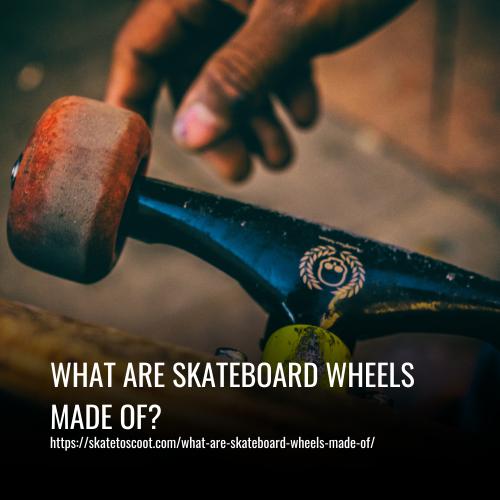As an Amazon Associate we earn from qualifying purchases.
Skateboard wheels are typically made out of polyurethane, a strong and durable material that’s resistant to wear and tear over time. This makes them great for riding across various surfaces while potentially avoiding surprises on your journey.
The durability of a skateboard wheel is determined by the number of urethane connections that comprise it. With more chain links, the wheel’s connecting chains will be longer and more stable, giving you a better ride experience that can withstand the test of time.
Choose your skateboard wheel wisely! Select one made with polyurethane to ensure that you get ultimate strength and stability, along with a smooth ride without any nasty surprises down the road.

What Are Skateboard Wheels Made Of?
Skateboard wheels are typically made out of polyurethane, a strong and durable material that’s resistant to wear and tear over time. This makes them great for riding across various surfaces while potentially avoiding surprises on your journey.
Materials:
Here we can discuss the materials that we found from a Skateboard Wheels
1. Polyurethane Wheels:
Polyurethane is the key material that makes skateboarding possible. Without this revolutionary invention, there wouldn’t be near as many skateboard wheels on the market today. Thanks to its elastic nature, you can set up and tune your board quickly, giving you a speedy ride without worrying that your wheels will slip out of control.
The durable polyurethane material also ensures superior grip, allowing for a smooth and stable ride with enhanced abrasion resistance. To make the most out of these incredible wheels, manufacturers combine two different forms of polyurethane – diisocyanates, and polyols – to create a lasting wheel that meets all your skateboarding needs.
2. Why Is Polyurethane Used To Make Skateboarding Wheels?
Polyurethane is the ideal material for making skateboarding wheels due to its characteristics and versatility. Its flexibility enables manufacturers to get the perfect blend of hardness and softness, as well as allows them to shape, color, and design the wheels however they would like. This makes it incredibly durable and resistant to abrasion, tear, impact, and more!
The polyurethane used in skateboarding wheels also differs from that which is used in other products such as mattresses, insulation, adhesives, coatings, composite wood panels, car parts, and so on. The resilience and compression of polyurethane make it an optimal choice for items that experience regular use or impact such as tires and soles of shoes.
Overall: Polyurethane’s durability, versatility, and ability to adapt to different shapes make it a great option for creating skateboarding wheels. Not only will you be able to find your desired levels of hardness or softness with polyurethane; but you can also customize the design elements too!
3. What Is Polyurethane?
Polyurethane is an incredibly versatile polymer, formed by multiple monomers or molecules that are fused using urethane bonds. Despite its name, polyurethane doesn’t contain any urethane. Instead, it’s bound by a group of organic substances called carbamates which give it its unique properties.
Unlike other polymers, polyurethane does not have a specific starting monomer. This means you won’t know exactly what is in the polyurethane used in products like skateboarding wheels until you ask the manufacturer. Fortunately, many companies are willing to offer warranties against all manufacturing defects, as they’re confident in their polyurethane products.
This is why polyurethane has become so popular: it’s strong and can be used for a wide variety of applications ranging from furniture to sporting equipment, and more!
The History of Skateboard Wheels
Skateboard wheels have a long history of evolution and now, modern technology has created the perfect wheel for any skateboarding style. It all began in the early 1900s when some creative youngsters took old roller skate wheels and attached them to 2 by 4 boards. While these steel wheels had a lot of power, they were not very effective because they lacked traction.
The 1950s marked the first commercial production of skateboards, still with metal wheels. In the 1960s, manufacturers turned to clay wheels as an alternative- but this was unfortunately only marginally better than the metal wheeled boards.
Then in 1970, Frank Nasworthy came up with the idea to use polyurethane rollers for skateboards instead. Seeing how well they worked on roller skates, Frank believed that urethane wheels would be just as beneficial for skating. Sure enough, he was right – because with better traction and resiliency from polyurethane’s urethane material, this combination formed what is considered modern-day skateboarding today!
How Are Skateboard Wheels Made?
The process of making a skateboard wheel is an intricate science. To make these wheels as resilient, traction-rich, and high rebound as possible, the transition from metal wheels to urethane was made.
The manufacturing of skateboard wheels starts with combining polyurethane components to create a material that is heated in the correct ratio by a metering machine until it liquefies. This liquid then gets put into aluminum molds and cooled until it solidifies.
Once it has hardened, the formed wheels are cured on trays and cut by a lathe so its radius and riding surface can be pre-determined. To finish off, digital artworks are converted into film so they can be transferred onto the wheel itself.
No wonder why skateboarders choose urethane wheels above the rest – all this work goes into making each wheel ready for the streets!
What Were Skateboarding Wheels Made of Before Polyurethane?
Before polyurethane was used as the material of choice for skateboarding wheels, a variety of other materials were experimented with. The oldest mass-produced skateboarding wheels were made out of steel, and for about five decades, this alloy dominated the market. Unfortunately, these steel wheels lacked the necessary grip needed for a smooth ride and had difficulty controlling speed.
In the 1950s, clay was briefly used to create skateboard wheels, but this endeavor proved unsuccessful due to the lack of compressibility combined with little or no cushioning or rebound effect. Polyurethane was eventually chosen as the best material when it came to skateboard wheel production, offering superior attributes in comparison with its predecessors.
Metal Skateboard Wheel
Metal skateboard wheels have been around since the 1950s and many pro skaters fondly remember their early days of skateboarding with metal wheels. What’s great about metal wheels is that they are strong and durable, and provide smooth rolling on a variety of surfaces.
Unfortunately, metal skateboard wheels tend to become clogged with dirt, dust, and sand which affects their ability to roll smoothly. That is why manufacturers developed clay wheels in an attempt to address these issues, but even clay wheels can wear out quickly and easily.
Ultimately, for those looking for maximum durability and speed on their skateboards, metal skateboard wheels are still the preferred choice among experienced skaters. With proper maintenance and care, metal wheels can last much longer than other types of skateboard wheel materials ensuring that your ride stays smooth and fast!
Why Should You Choose Polyurethane Wheels?
Polyurethane wheels offer a great combination of grip, speed, and durability that makes them the ideal choice for skateboarding. They provide superior grip on any surface, allowing you to easily maneuver your board with confidence.
1. Benefits:
Choosing a polyurethane wheel has many benefits. For starters, manufacturers can easily adjust the durometer of these wheels by controlling the chemical component foundation during production. This makes them highly durable and able to stand up to any terrain you might skate over.
They also give you excellent grip, making it easier for you to control your skateboard. Finally, modern polyurethanes offer incredible durability and longevity- you can still enjoy top of the line speed and performance without a pneumatic tube.
2. Drawbacks:
Choosing polyurethane wheels can have environmental drawbacks due to their manufacturing and recycling process. The production of polyurethane requires a lot of energy, both chemical and thermal, along with substantial greenhouse gas emissions, making it quite damaging to the environment.
Similarly, recycling these Polyurethane wheels also involves a lot of energy, as well as emits huge amounts of emissions into the atmosphere.
Ultimately, the greatest drawback of choosing Polyurethane wheels is their significant contribution to environmental pollution.
What Are Spitfire Wheels Made Of?
Spitfire Wheels are made of cast aluminum and plastic, but there’s more to it that gives them their exceptional qualities. The urethane they use is specially designed for cruisers and skateboards, giving the wheels unmatched durability and a smooth ride.
Say goodbye to broken or bent wheels – the urethane gives Spitfire Wheels a high durometer so you won’t have to worry about them deteriorating prematurely. And because Formula Four urethane adds gripping power even when wet, your wheels won’t fail you in damp conditions.
In addition to these amazing features, Spitfire also offers two different sizes – 32-inch and 36-inch diameters – so practically any vehicle or type of foot size will be accommodated. Plus, all the urethanes used in their processes are non-toxic and long-lasting, meaning you can enjoy safe rides for years to come!
Were Skateboard Wheels Made Out Of Clay?
It is widely believed that skateboard wheels were first made from clay. Many assume that this was because the clay was strong and easy to mold into the right shape.
However, as it turns out, skateboard wheels were not made of clay for very long. Clay proved to be too brittle and did not offer enough durability for effective use on a skateboard. It also failed miserably in several other aspects, such as its inability to withstand extreme temperatures.
Urethane emerged in the early 1900s as a superior wheel material compared to clay. Urethane is much more durable than clay and is still used today by professional skaters who need top-notch performance from their boards.
In addition, while steel skateboards have been around since the beginning, some amateur skaters still prefer the distinctive feel of completing tricks with Clay Wheels – something that cannot be replicated with steel wheels.
Why Are Skateboard Wheels Soft?
Skateboard wheels are designed to give you the best experience possible when cruising and tricking around on the ground. That’s why they tend to be on the softer side. And, compared to hard skateboard wheels, soft skateboard wheels will grip smoother surfaces better. The durometer reading of a skateboard wheel can indicate its hardness; the lower the number, the softer the wheel, and conversely, the higher the number, the harder it is.
You’ll find different brands of skateboards offering different durometer ratings and this affects how much grip their wheels will provide over rough terrains. So if you’re looking for responsive performance from your skateboard, consider getting those that feature softer wheels as these offer better control, maneuverability, and traction over varied terrain.
FAQs
PU wheels have a grip that’s comparable to rubber and are much more resilient due to their polyurethane design, making them suitable for both off-road and paved surfaces.
Skateboard wheels are crafted from polyurethane, as it is a reliable material with excellent properties such as firmness and longevity, making it ideal for skateboarders due to its economical production process.
If your old skateboard wheels are still usable, donate them to Satori Wheels. This eco-friendly project values recycling these parts.
Urethane is used to construct long-lasting skateboard wheels.
Skateboarding wheels are available in three primary varieties: street, cruiser, and longboard. Street skateboard wheels are smaller than those used for cruising or longboarding, while longboard wheels offer greater diameter sizes and a wider selection of shapes. Skatepark wheels are specifically designed to be used in public parks and streets.
Polyurethane wheels are ideal for use outdoors if your work requires operating in wet and/or humid climates.
Constructing a great skateboard wheel requires several factors to be taken into account. For street riding and tricks, a harder wheel is best; however, softer wheels are better for smooth surfaces. Some skate companies even produce customized wheels specially designed for their decks.
Blind wheels offer more than regular wheels; they have increased rebound, providing enhanced power and stability on the ice. Furthermore, they are quieter and easier to navigate in limited spaces.
You may have been seeking something else when you encountered the subject of maple skateboards. Unfortunately, these boards don’t perform as their advertisements suggest. New riders should consider more affordable options that aren’t equipped with inadequate bearings or wheels.
No, the skateboard wheels are manufactured from polyurethane. The plastic wheels do not yield stability. Plus, the plastic-manufactured wheels are not durable. Therefore, these are not plastic or rubber skateboard wheels but instead polyurethane.
Conclusion:
Skateboard wheels are an important part of any skateboarder’s setup, and understanding what they are made of is key to getting the right wheels for your board. Whether you want traditional urethane, filament-wrapped polyurethane, or all-plastic wheels will depend heavily on the specific skateboarding style you like best.
No matter which wheel you choose for your board, consider the level of grip and performance you need so that you can get the best possible experience while riding your skateboard.
Amazon and the Amazon logo are trademarks of Amazon.com, Inc, or its affiliates.



